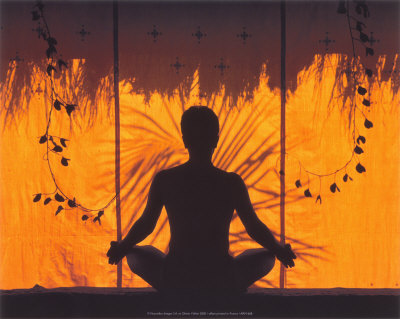Hari
OM
Monday is AUM-day; in search of meditation.
How
did you find Process One in the practice of OM meditation? It is quite a good
idea to keep a small notebook to hand for when you emerge from each session.
Before rising from aasana, simply write down keywords - whatever the first main
thoughts are now battling for your attention. Why do this? It is a measure, a
gauge of progress. You may think you will remember, but just as photographs of
our youth can jog the memory of how embarrassingly naïve we were, so can this
'snapshot' book! This is a good thing.
To be able to say at some stage later "ah the innocence".
Process
one itself is very powerful and many folk remain using that technique all their
lives. There are other processes which can be utilised though. We shall go
through these one at a time, giving you a full week to practice each. In this
way you can find which one suits your current state of being. Then you can
select and practice only that one until such time as a natural progression
brings you to using another of the processes. For some folk, different
processes suit different days - this possibility is always there, but generally
speaking it is advisable to become adept in one at a time.
PROCESS
TWO.
Using
the breath as the mantra. Still visualise the OM, however, instead of chanting
aloud, 'hear' the OM with each out breath. The rhythm of breathing must be
maintained just as in process one.
As
you do this, you may find automatically that the OM begins to 'chant' on the in
breath also! This is fine. Even if it doesn't, you may like to experiment with
doing this. OM in both directions of breath. This can bring a different
dimension altogether in the understanding of the presence of OM. It is quite
profound. The difference in rhythm will begin to manifest more here - a natural
slowing and deepening. The cyclical process brings a harmony, a synchronicity,
to the BMI and OM.
SAADHANA.
As
before, utilise this in daily practice for the allotted 20 - 30 minutes. The
timing is given purely as a guide. What
the majority of people experience when beginning these exercises is that there
is a natural finish point. It can (though not always) be found to relate to the
person's speed and tone. The quicker and higher the chanting (whether aloud or
silently), often the shorter the meditation. No thought is involved. It just
happens.
It
is advisable, of course, to be sure that your session is not being jammed
between two important appointments! Remember the suggested optimal time is after
morning bathing but before breakfast… this leads one to consider that rising
earlier than perhaps has been the case till now is required. This you must
determine for yourselves. One can meditate at lunchtime, or after work, but
this often comes with 'baggage' of the day. To meditate before entering the
fray generally prepares one better and means that the mind is already,
usually, in a calmer state.
[Traditionally, ब्रह्म मुहुर्त/Brahma muhurta (God's hour) is used
for meditation (and such hatha practices as suryanamaskaar - salute to the
sun). It is the period which begins approximately one and a half hours before
sunrise. In ashram, the bell would ring at 4am and by 5am chanting would begin…]


